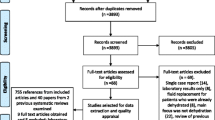Abstract
Little is known about the impact of behavioral changes after the 2003 heat wave on hydration status of elderly citizens in France. We used an administrative data file provided information about 23,022 inpatients aged ≥70 years admitted between 2000 and 2006, including vital status at discharge and Charlson comorbidity index and matched it with the result of five blood tests (sodium, potassium, glucose, urea nitrogen, creatinine) within the first 24 h after admission and with daily temperatures before admission. We then measured the prevalence of plasma tonicity (PT) <275 mOsm/l or >300 mOsm/l, blood urea nitrogen/creatinine ratio (BUNC) >100 and inhospital mortality. In 2000–2002, 2003, 2004–2006, prevalence (%) was, respectively 7.5, 8.0, 9.5 (P < 0.0001) for PT < 275 mMol/l, 8.4, 10.4, 7.2 (P < 0.0001) for PT > 300 mOsm/l, and 35.4, 30.7, 26.7 (P < 0.0001) for BUNC > 100. Inhospital mortality rate was 10.8, 10.8 and 9.0%, respectively (P < 0.0001). After adjustment for covariates, OR (95% CI) in 2004–2006 with reference to 2000–2002 was 1.26 (1.13–1.39) for PT < 275 mMol/l, 0.85 (0.76–0.94) for PT > 300 mOsm/l, and 0.65 (0.61–0.69) for BUNC > 100. Inhospital mortality risk associated with hydration disorders did not vary significantly over periods for PT < 275 mMol/l (HR 1.06 to 1.40) and PT > 300 mOsm/l (HR 1.76 to 1.96) but was lower for BUNC > 100 in 2003 (HR 1.27) than in 2000–2002 (HR 1.64) or 2004–2006 (HR 1.77) (P = 0.04). So, since the 2003 heat wave, significant shifts in prevalence of intracellular hydration disorders indicate behavioral changes with positive impact on hydration status.


Similar content being viewed by others
References
Fouillet A, Rey G, Laurent F, et al. Excess mortality related to the August 2003 heat wave in France. Int Arch Occup Environ Health. 2006;80(1):16–24.
Gremy I, Lefranc A, Pepin P. Consequences sanitaires de la canicule d’aout 2003 en Ile-de-France. Rev Epidemiol Sante Publique. 2004;52(1):93–8.
Mario N, Pernet P, Lasnier E, Hermand C, Vaubourdolle M. Effect of August 2003 heat wave in France on a hospital biochemistry laboratory activity in Paris. Ann Biol Clin (Paris). 2004;62(3):356–60.
World Health Organization. ICD-10 : international statistical classification of diseases and related health problems. 10th revision. ed. Geneva: World Health Organization; 1992.
Stookey JD. High prevalence of plasma hypertonicity among community-dwelling older adults: results from NHANES III. J Am Diet Assoc. 2005;105(8):1231–9.
Aronson D, Mittleman MA, Burger AJ. Elevated blood urea nitrogen level as a predictor of mortality in patients admitted for decompensated heart failure. Am J Med. 2004;116(7):466–73.
Climate Assessment & Dataset (ECA&D) project. http://eca.knmi.nl. Accessed 12 Feb 2007.
Klein Tank A, Wijngaard J, Können G, et al. Daily dataset of 20th-century surface air temperature and precipitation series for the European climate assessment. Int J Climatol. 2002;22(12):1441–53.
Charlson M, Szatrowski TP, Peterson J, Gold J. Validation of a combined comorbidity index. J Clin Epidemiol. 1994;47(11):1245–51.
Charlson ME, Pompei P, Ales KL, MacKenzie CR. A new method of classifying prognostic comorbidity in longitudinal studies: development and validation. J Chronic Dis. 1987;40(5):373–83.
Quan H, Sundararajan V, Halfon P, et al. Coding algorithms for defining comorbidities in ICD-9-CM and ICD-10 administrative data. Med Care. 2005;43(11):1130–9.
Klein L, O’Connor CM, Leimberger JD, et al. Lower serum sodium is associated with increased short-term mortality in hospitalized patients with worsening heart failure: results from the Outcomes of a Prospective Trial of Intravenous Milrinone for Exacerbations of Chronic Heart Failure (OPTIME-CHF) study. Circulation. 2005;111(19):2454–60.
Tierney WM, Martin DK, Greenlee MC, Zerbe RL, McDonald CJ. The prognosis of hyponatremia at hospital admission. J Gen Intern Med. 1986;1(6):380–5.
Brunsvig PF, Os I, Frederichsen P. Hyponatremi. En retrospektiv studie med henblikk pa forekomst, arsak og mortalitet. Tidsskr Nor Laegeforen. 1990;110(18):2367–9.
Hartz AJ, Kuhn EM, Kayser KL, Johnson WD. BUN as a risk factor for mortality after coronary artery bypass grafting. Ann Thorac Surg. 1995;60(2):398–404.
Kirtane AJ, Leder DM, Waikar SS, et al. Serum blood urea nitrogen as an independent marker of subsequent mortality among patients with acute coronary syndromes and normal to mildly reduced glomerular filtration rates. J Am Coll Cardiol. 2005;45(11):1781–6.
Valleron AJ, Boumendil A. Epidemiologie et canicules : analyses de la vague de chaleur 2003 en France. C R Biol. 2004;327(12):1125–41.
Belmin J, Auffray JC, Berbezier C, et al. Level of dependency: a simple marker associated with mortality during the 2003 heat wave among French dependent elderly people living in the community or in institutions. Age Ageing. 2007;36(3):298–303.
Holstein J, Canoui-Poitrine F, Neumann A, Lepage E, Spira A. Were less disabled patients the most affected by 2003 heat wave in nursing homes in Paris, France? J Public Health (Oxf). 2005;27(4):359–65.
Misset B, De Jonghe B, Bastuji-Garin S, et al. Mortality of patients with heatstroke admitted to intensive care units during the 2003 heat wave in France: a national multiple-center risk-factor study. Crit Care Med. 2006;34(4):1087–92.
Davido A, Patzak A, Dart T, et al. Risk factors for heat related death during the August 2003 heat wave in Paris, France, in patients evaluated at the emergency department of the Hopital Europeen Georges Pompidou. Emerg Med J. 2006;23(7):515–8.
Michenot F, Sommet A, Bagheri H, Lapeyre-Mestre M, Montastruc JL. Adverse drug reactions in patients older than 70 years during the heat wave occurred in France in summer 2003: a study from the French PharmacoVigilance Database. Pharmacoepidemiol Drug Saf. 2006;15(10):735–40.
Fouillet A, Rey G, Jougla E, Hémon D. Estimation de la surmortalité observée et attendue au cours de la vague de chaleur du mois de Juillet 2006. BEH. 2007;2007:192–4.
de Groot V, Beckerman H, Lankhorst GJ, Bouter LM. How to measure comorbidity. A critical review of available methods. J Clin Epidemiol. 2003;56(3):221–9.
Author information
Authors and Affiliations
Corresponding author
Rights and permissions
About this article
Cite this article
Kettaneh, A., Fardet, L., Mario, N. et al. The 2003 heat wave in France: hydratation status changes in older inpatients. Eur J Epidemiol 25, 517–524 (2010). https://doi.org/10.1007/s10654-010-9478-9
Received:
Accepted:
Published:
Issue Date:
DOI: https://doi.org/10.1007/s10654-010-9478-9




